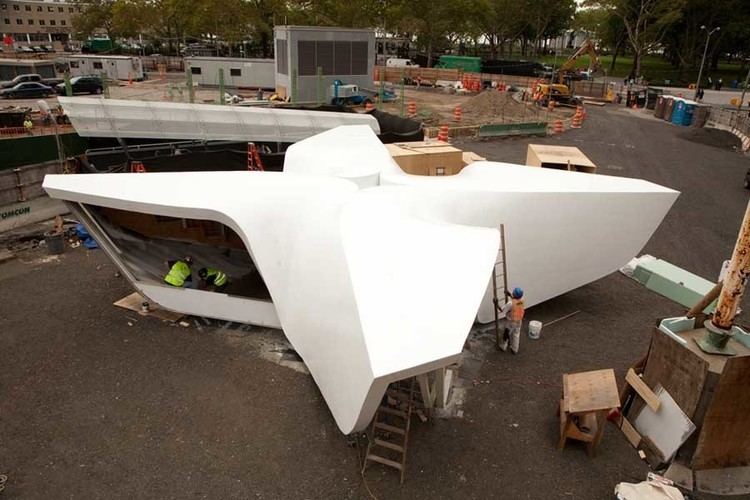 | ||
Similar New York Crystal Palace, Canterbury Hall (New York City), Aaron Davis Hall | ||
The New Amsterdam Plein and Pavilion, designed by Ben van Berkel of UNStudio (Architect of record, Handel Architects, New York), is a gift from the Netherlands to New York in honor of 400 years of friendship on the anniversary of Henry Hudson’s arrival in New York.
Contents
- Overview
- History
- Architect
- Inspiration
- Philosophy
- Site and context
- Form and use
- Construction
- Sustainable design
- Significance
- References
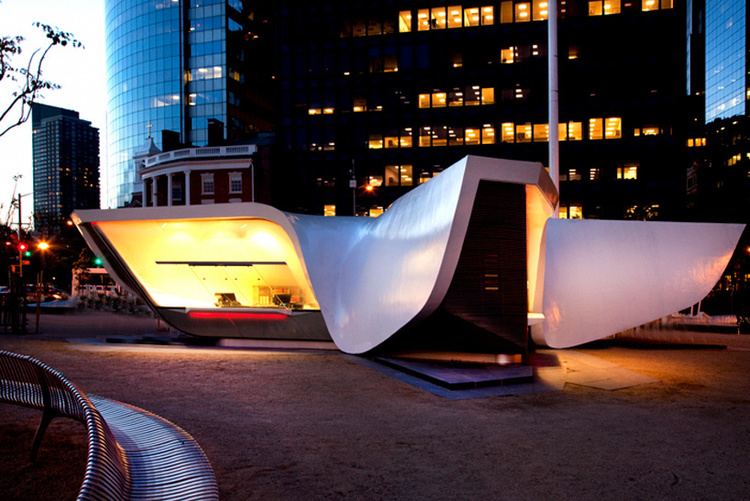
Overview
The $2.4 million 500 square foot Pavilion is located on Peter Minuit Plaza just outside Battery Park in Downtown NYC. The Pavilion’s opening day was celebrated on September 9, 2009 and was officially open to the public on May 12, 2011. The pin wheel shaped Pavilion and now downtown’s new cultural hub is home to the organic Merchants Market café and acts as an interactive information center about all there is to see and do in NYC. The surrounding Plein and seating was also designed by Ben van Berkel and is also meant to be a space for both scheduled and spontaneous activities. The Pavilion is positioned in a heavy traffic area just a few feet north of the South Ferry (ferry) and next to the South Ferry – Whitehall Street (New York City Subway) making this a busy intersection that is crossed by approximately 70,000 residents and visitors on a daily basis.
History
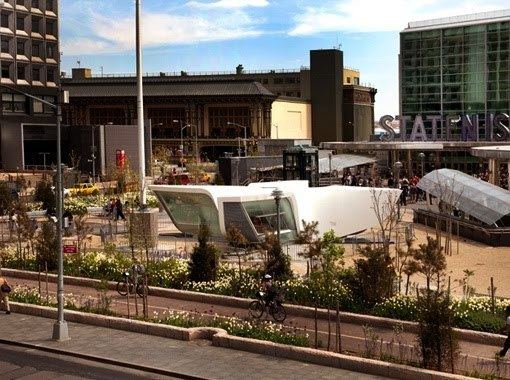
The New Amsterdam Pavilion is an addition to the ever changing downtown Manhattan area that was once dominated by the shipping industry. Over time these businesses moved to Brooklyn and New Jersey making room for other commercial business and residential buildings in the area. This resulted in increased population density of the downtown area and the need for redevelopment. These efforts to redevelop the area are ongoing with the Battery Conservancy’s need to redevelop Battery Park. The realization of the New Amsterdam Pavilion was made possible by initiatives undertaken by the Battery Conservancy in 1952 when they removed a section of Battery Park’s original plan to make room for a larger South Ferry Terminal. This paved the way for the creation of Peter Minuit Plaza, a plaza named after the Dutch merchant, representative of the Dutch East India Company, who is known for brokering the deal between the Dutch and the Lenape Indians to share the island. When Henry Hudson first arrived on the island in 1609 it was named Manna-Hata by Native Americans and was soon established as a desirable location for the new Dutch settlement. The first Dutch settlers arrived in 1626 and renamed it New Amsterdam. The Pavilion is geographically located at the mouth of the Hudson River marking the downtown area where NYC started its development and is placed on the plaza named after the famed Dutch merchant making the location of the New Amsterdam Pavilion ideal.
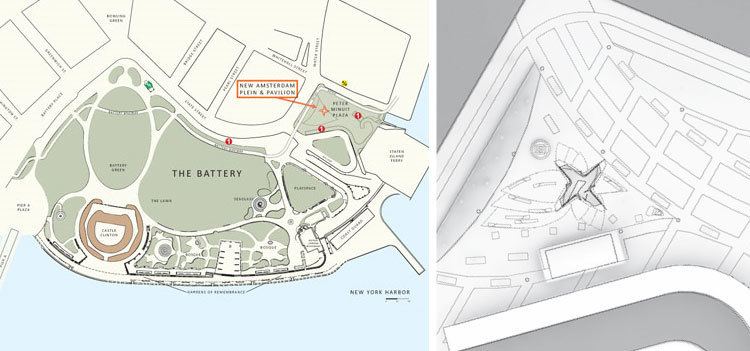
The New Amsterdam Pavilion is an addition to the ever-changing area of downtown Manhattan, once dominated by the shipping industry. Over time these businesses moved to Brooklyn and New Jersey making room for other commercial business and residential buildings. This construction resulted in increased population of the downtown area and the need for more services including redevelopment of Battery Park. Earlier redevelopment initiatives undertaken in 1952 made the location of the Pavilion possible when a section of Battery Park was removed to make room for a larger South Ferry Terminal. The effort is ongoing, led by the Battery Conservancy and it has made it possible to realize the New Amsterdam Pavilion. The Conservancy is a not-for-profit educational corporation that was created to revamp the park. The 25 acre Battery Park is not a remnant of the nature that once was, it was created by landfill during the 19th Century and is home to many monuments and memorials. It got its name from the “artillery batteries” that were once positioned there to protect the settlement.
The Pavilion is geographically located at the mouth of the Hudson River and marks the downtown area where the urban settlement that became New York City, started. Currently, the Pavilion is vacant. It is expected that the Pavilion will serve coffee and Dutch food related items as of December 2013.
Architect
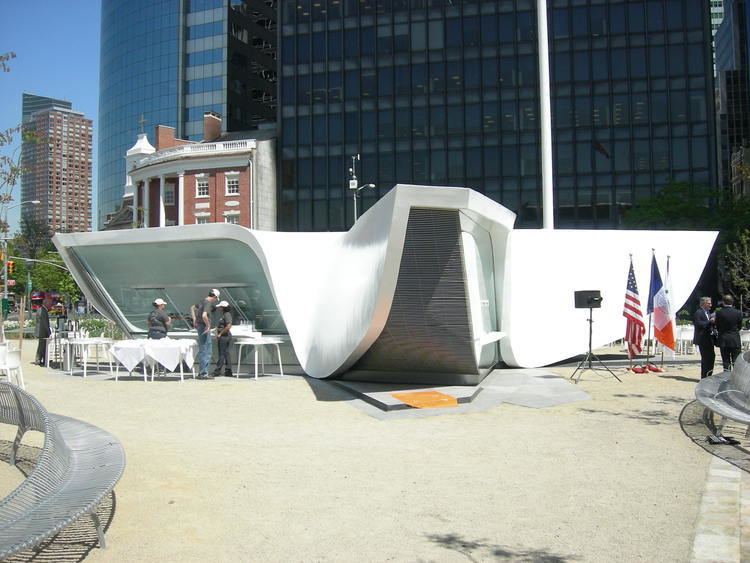
Ben van Berkel is a Dutch architect born in 1957 in Utrecht, Netherlands. He studied architecture at the Gerrit Rietveld Academie in Amsterdam and the Architectural Association School of Architecture in London. He started his first practice in Amsterdam 1988 along with Caroline Bos called Van Berkel & Bos Architectuurbureau. The practice found success through projects such as the Erasmusbrug and the Moebius House, among others. In 1998 the name of the practice was changed to UNStudio (UN stands for ‘United Net’) and has continued to build its international reputation.
Inspiration
Van Berkels practice was built on the exploration of technology and material innovation, qualities reflected in the New Amsterdam Pavilion. His inspiration comes from an everyday habit of sketching and curiosity about how to apply cutting edge technology to building. He tends to bounce his inspirations off teammates and seeks collaborating with designers outside of architecture, such as fashion.
Philosophy
Van Berkel has no specific architectural style and does not believe in one. One of the most important steps in his design process is the organizational aspect of architecture that begins in sketching where he tries to combine all ideas.
Site and context
Its location on the mouth of the Hudson River, where Henry Hudson found a desirable location for the new Dutch settlement and the birthplace of NYC, and on Peter Minuit Plaza, the Dutch merchant who negotiated the deal with the Lenape Indians, make the site historically appropriate. As the site was once part of Battery Park and on the southern tip of the island, the site is open to light and air without the feeling of oppression by the surrounding skyscrapers. The size of the triangular site is approximately 125’x145’x160’. This location offers high pedestrian traffic due to the South Street Ferry Terminal, just a few feet away from the Pavilion, as well as the South Ferry Subway station that become essential to the success of this public building. Contextually, the building looks very different from any of the surrounding structures but its single story curvilinear organic form seems to belong as part of the park setting.
Form and use
The Pavilion’s form is based on a pinwheel plan spreading the building’s program away from its center while truly mimicking a pinwheel with equally sweeping curvilinear forms. Programmatically, the center of the building houses more permanent and private functions and the tips are usually occupied by concession stands and the information booth which includes an interactive projection. Occasionally these spaces become home to temporary art installations and exhibits. The building’s form divides the plaza into four public outdoor spaces for a various functions and events and breaks up the heavily trafficked area with its befitting dynamic shape.
Construction
Materiality of the Pavilion was kept simple with the use of glass, wood and steel. The Pavilion’s complex form is made up of wood ribs and a steel frame. The envelope is made up of plywood and polyurea coating. With only a nine-month period to complete the project the Pavilion was prefabricated in Virginia and hauled to and pieced together on site to speed up the process. Glass allows views of the interior spaces providing glimpses of current installations and access to the Pavilion’s concession stands and information booth. Another notable part of the design is the LED lighting of the Pavilion. Every night at midnight the Pavilion exhibits an array of different colors as a tribute to Peter Minuit whose name translates to “midnight” form French.
Sustainable design
The building’s design takes into account the need to passively ventilate the space. The form of the building and its location in open space makes it easy to take advantage of cross ventilation that is achieved through shading fins that allow hot air to escape while protecting against the rain and reducing the need for active heating and air conditioning systems (HVAC). The building’s structure utilizes a low maintenance steel that is fully concealed within the building’s shell as are all of the mechanical, electrical, and plumbing systems. The Pavilion was pre-fabricated and hauled onto the site where it was pieced together along with its steel structure that was created through a file to factory process. Despite the attempt at sustainability of this structure the costs are considerable and some of the materials used are questionable. The carbon footprint of some of the materials such as polyuria (commonly used in the making of spandex) and corian (made up of acrylic polymer and alumina trihydrate) used in the building’s interior are questionable in regards to sustainability.
Significance
The significance of the New Amsterdam Pavilion is directly related to its location on the southern tip of Manhattan Island. This area of heavy pedestrian traffic required an intervention that catered to commuters as well as to the many tourists who frequent this location. Upon exiting any of the major transportation hubs that surround the pavilion there is an explosion of open city space with a dense skyscraper filled backdrop. The pavilion mediates the space between the traveler and the city and provides food and information services that can direct a person to interesting city life away from the water’s edge. This is very helpful in the difficult to navigate downtown area that is consumed by the presence of named and not numbered streets. The need for such a structure here has subsequently made the Pavilion an instant landmark.
Structures that provide information are necessary for the function of society, even though the invention of the smartphone seems to render them obsolete (along with the payphone). The pavilion is like a huge turnstile that regulates heavy pedestrian traffic. The formal expression is fitting as the sweeping dynamic shapes reflect the constant movement around the structure. In addition, the plan has produced an array of exterior spaces that feel like rooms; some are more private than others depending on the building’s orientation. The area of Peter Minuit Plaza surrounding the Pavilion has also been redesigned with landscape elements and some interesting and curvilinear shaped metallic park benches that become part of the landscape.
